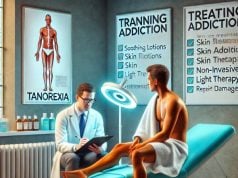
Body-modification addiction is more than an enthusiasm for tattoos, piercings, implants, or cosmetic procedures—it’s a compulsive drive to keep altering one’s body even when the costs outweigh the benefits. People caught in this cycle often describe an irresistible urge to chase the “next” change for relief, identity, or belonging. Left unchecked, the habit can strain health, finances, relationships, and self-esteem. In the guide below, we’ll unpack how widespread the problem is, why it develops, how to spot it early, the toll it can take, and—most importantly—the evidence-based paths to healing and lifelong recovery.
Table of Contents
- Understanding Scope and Numbers
- Why It Happens and Who’s Vulnerable
- Spotting It Early: Red Flags and Getting a Diagnosis
- Ripple Effects on Body, Mind, and Social Life
- Road to Healing: Therapies, Support, and Long-Term Care
- Your Questions Answered (FAQ)
Understanding Scope and Numbers
Modern surveys suggest that up to 40 % of adults in Western countries have at least one tattoo, and roughly 25 % have multiple piercings. While most modify safely and stop when satisfied, a small yet growing subset experiences an addictive pattern—craving continuous or extreme alterations despite complications. Prevalence estimates hover between 1 % and 3 % in the general population, climbing to 8 %–15 % among body-art enthusiasts and specific subcultures (e.g., extreme tattooing, scarification, and aesthetic surgery communities).
Key numbers to keep in mind:
- Gender balance: Historically male-dominated, but recent data show near-equal rates among men and women.
- Age of onset: First significant modification often occurs between 16 – 21, yet compulsive escalation typically appears in the mid-20s.
- Global spread: Rising popularity in North and South America, Europe, and parts of Asia; emerging interest in urban regions of Africa.
Why does prevalence appear to rise? Social media glamorizes elaborate body art, streaming platforms showcase transformation shows, and cosmetic technologies become cheaper and more accessible. The combination normalizes modification while lowering perceived risk—fertile ground for compulsive behavior to germinate.
For public-health planners, recognizing these numbers highlights the need for screening in dermatology, cosmetic surgery, and mental-health clinics. Consistent prevalence data also aid policymakers in drafting safety regulations for tattoo parlors, piercing studios, and unlicensed providers who target vulnerable clients seeking frequent modifications.
Why It Happens and Who’s Vulnerable
Body-mod addiction rarely has a single cause. Instead, multiple forces converge and reinforce one another until a feedback loop forms. The major contributors include:
Psychological Drivers
- Dopamine reward cycle: Fresh ink, a new stud, or a surgical tweak releases a rush of neurotransmitters. Over time, the brain learns to crave the next procedure to replicate that high.
- Identity crafting: For individuals who feel unseen or misunderstood, external modifications become a tangible way to narrate their story or reclaim agency.
- Maladaptive coping: Pain during procedures acts as emotional distraction, while the post-procedure attention offers fleeting validation.
- Perfectionism and body dysmorphic tendencies: Minor perceived flaws become intolerable, leading to endless “fixes.”
Social and Cultural Influencers
- Peer reinforcement: Tight-knit subcultures praise bold aesthetic risks, equating bigger or more unusual work with higher status.
- Online comparison loops: Instagram, TikTok, and niche forums constantly showcase fresh ideas, stoking fear of missing out (FOMO).
- Professional incentives: Artists and surgeons gain revenue and reputational clout from repeat clients, unintentionally reinforcing the cycle.
Biological and Genetic Factors
- Impulsivity genes: Variations in dopamine-regulation genes (e.g., DRD2) have been linked to higher sensation-seeking traits.
- Comorbid disorders: ADHD, substance-use disorder, and obsessive-compulsive spectrum disorders share neural pathways with behavioral addictions, making cross-addiction more likely.
High-risk Profiles:
- Youth with prior self-harm or trauma histories who discover modification as a socially accepted form of pain release.
- Influencers or performers whose careers hinge on novel, eye-catching looks.
- Individuals with low self-esteem who experience intense relief when compliments follow a new procedure.
- Clients recovering from substance addictions who transfer compulsivity to body alterations.
Remember, vulnerability doesn’t equal destiny. Many people in these groups enjoy modifications without becoming addicted. However, understanding risk helps clinicians and loved ones intervene earlier.
Spotting It Early: Red Flags and Getting a Diagnosis
Because the behavior is legal and often celebrated as artistic expression, recognizing when enthusiasm crosses into addiction can be tricky. Look for patterns rather than isolated acts.
Behavioral Warning Signs
- Planning the next session while in the healing phase of the last one.
- Escalating intensity—larger tattoo areas, deeper gauge piercings, more radical implants.
- Neglecting work, study, or family commitments to schedule or pay for procedures.
- Hiding new modifications from partners or employers to avoid conflict or job loss.
Emotional and Cognitive Clues
- Anxiety or irritability when appointments are delayed.
- Short-lived satisfaction—feeling “unfinished” days after a procedure.
- Preoccupation with online images or forums about extreme body mods.
- Belief that personal worth hinges on achieving a specific look.
Physical and Financial Indicators
- Repeated infections, scarring, or allergic reactions that are ignored to keep modifying.
- Mounting debt or selling possessions to fund cosmetic work.
- Doctor-shopping for surgeons willing to perform risky or redundant procedures.
Diagnostic Pathway:
- Screening questionnaires. Instruments adapted from behavioral-addiction tools (e.g., Problem Gambling Severity Index) ask about cravings, tolerance, and harmful consequences.
- Clinical interview. A mental-health professional explores motivation, frequency, comorbidities, and distress levels.
- Medical assessment. Dermatologists or plastic surgeons document physical harm and healing complications.
- Differential diagnosis. Conditions like body dysmorphic disorder, borderline personality disorder, or non-suicidal self-injury must be ruled in or out, as treatment plans differ.
Early detection allows for stepped-care interventions—from brief motivational counseling to referral for specialized treatment—before irreversible damage accumulates.
Ripple Effects on Body, Mind, and Social Life
The consequences of body-modification addiction extend well beyond the studio chair.
Physical Health Risks
- Infections: Hepatitis B/C, HIV, and bacterial infections can arise from unsterile equipment.
- Chronic skin issues: Keloids, granulomas, hyperpigmentation, and implant rejection—even with reputable artists.
- Surgical complications: Anesthesia risks, scarring, nerve damage, and prolonged wound healing in repeat cosmetic surgeries.
- Immune overload: Frequent exposure to tattoo inks and metals stresses the immune system, occasionally triggering autoimmune flare-ups.
Mental and Emotional Strain
- Heightened anxiety or depression when the next procedure feels out of reach.
- Body image dissatisfaction despite extensive modifications, creating a perpetual cycle of “never enough.”
- Social isolation when friends or family cannot relate to extreme aesthetic choices.
Relationship and Occupational Fallout
- Conflict with partners over finances, time away, or dramatic appearance changes.
- Job discrimination—visible tattoos or implants may limit career progression in conservative industries.
- Legal or financial stress if unlicensed procedures lead to malpractice disputes.
Quality-of-Life Impact
Sleep disturbances, chronic pain from poorly healed sites, and restricted physical activity (e.g., sports that conflict with fresh piercings) erode day-to-day well-being. Over time, a once-joyful form of self-expression becomes an all-consuming chore.
Road to Healing: Therapies, Support, and Long-Term Care
Recovering from body-modification addiction is entirely possible. Success rates climb when treatment addresses both psychological cravings and practical lifestyle shifts.
Evidence-Based Therapeutic Modalities
- Cognitive-behavioral therapy (CBT): Reframes distorted beliefs (“I’m only attractive with more ink”) and builds alternative coping skills.
- Motivational interviewing: Helps ambivalent clients clarify conflicting feelings and set realistic change goals.
- Dialectical behavior therapy (DBT): Teaches distress-tolerance and emotion-regulation skills—particularly helpful for clients with self-harm histories.
- Acceptance and commitment therapy (ACT): Encourages values-based action, shifting focus from appearance to life purpose.
Medical and Dermatological Interventions
- Infection management: Prompt antibiotic or antiviral treatment for complications.
- Scar revision or tattoo removal: Laser therapy or surgical excision may reduce regret-related distress.
- Pharmacotherapy: SSRIs or naltrexone can dampen compulsive urges in some cases.
Peer and Community Support
- 12-step or peer-led groups: Emerging fellowships (e.g., “Ink Anonymous”) provide safe spaces to share struggles.
- Online recovery forums: Moderated communities offer anonymity and global connection.
- Mentorship programs: Pair newcomers with mentors who have maintained abstinence or moderation for at least a year.
Personal Recovery Strategies
- Create a delay rule. Commit to a 90-day waiting period before any new procedure—cravings often fade when time passes.
- Budget guardrails. Set a monthly cap for aesthetic spending and use automated savings apps to enforce it.
- Identity-expansion activities. Cultivate hobbies (music, sport, volunteering) that reinforce self-worth beyond appearance.
- Body-neutral mindfulness. Practices like yoga nidra and progressive muscle relaxation reduce urge intensity by grounding clients in bodily sensations without judgment.
Relapse Prevention
Just as with substance addictions, lapses can happen. A solid prevention plan includes:
- Recognizing early warning signals—bookmarking clinic websites, binge-scrolling modification hashtags, or bargaining (“just one more piercing”).
- Having a “call list” of supporters and professionals to reach out to when urges spike.
- Scheduling periodic skin and mental-health check-ups to catch complications or emotional triggers promptly.
Recovery isn’t about rejecting body art forever. Many achievers eventually return to moderate, intentional modifications without relapse—proving that control, not abstinence, is the ultimate goal for some.
Your Questions Answered (FAQ)
Is body-modification addiction officially recognized?
Not yet in the DSM-5, but clinicians treat it under behavioral addiction or body-dysmorphic frameworks, using evidence-based therapies adapted from similar disorders.
Can tattoo removal cure the addiction?
Removal may ease regret, but it doesn’t address underlying compulsions. Counseling, skills training, and support groups are key to lasting change.
How long does treatment usually take?
Average CBT programs last 12–16 weeks, but many people benefit from booster sessions and peer support for a year or longer.
Are certain tattoo styles more addictive?
No style is inherently addictive, yet large-scale or painful procedures release stronger endorphin surges, which can reinforce compulsive patterns faster.
Is complete abstinence necessary?
Not always. Some recover by limiting procedures to special milestones. Others choose abstinence if moderation repeatedly fails.
Can friends help without shaming?
Yes—express concern, avoid criticizing appearance, and offer to research counselors together. Supportive curiosity beats judgment every time.
Disclaimer
This article is for educational purposes only and is not a substitute for professional medical, psychological, or dermatological advice. Always consult qualified healthcare providers for diagnosis, treatment, and personalized guidance.
If you found this guide helpful, please consider sharing it on Facebook, X (formerly Twitter), or any platform you love. Your support helps us keep creating in-depth, reader-first resources—thank you!










